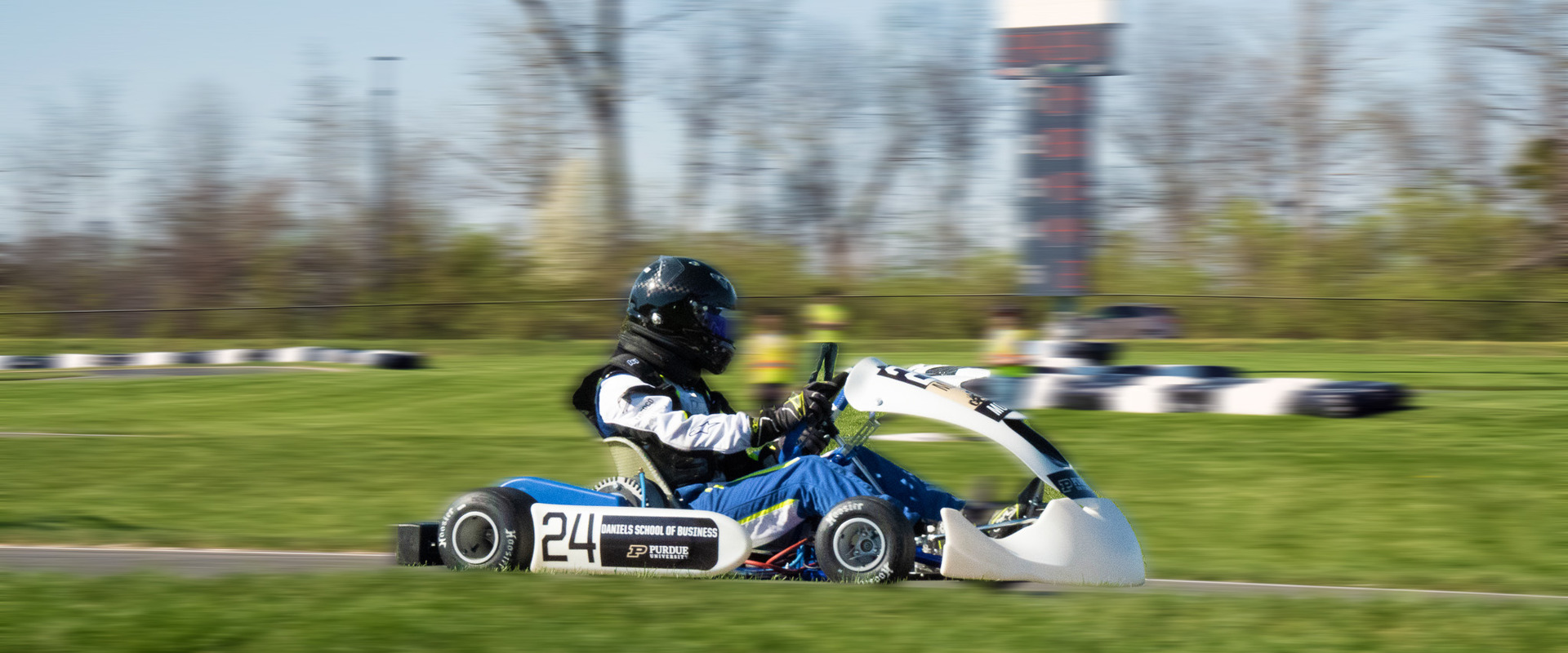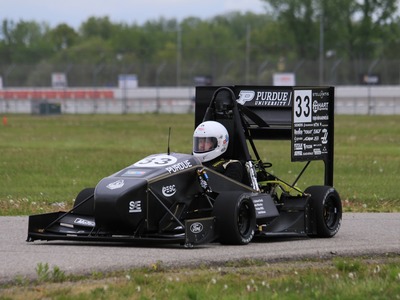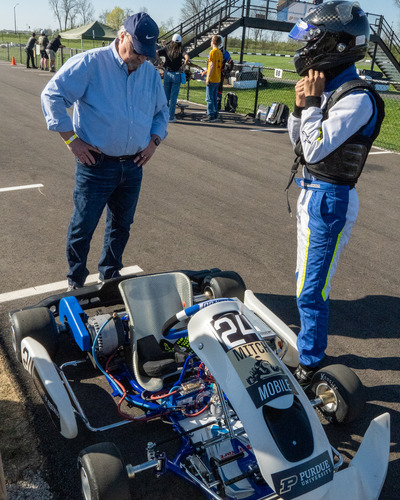
04-10-2024
My road to Purdue University began in the sixth grade when I began go-karting. I’m from Sammamish, WA, and my parents took me to a K1 speed track there and another in Redmond. I learned the ropes fast and my parents were super supportive of me, taking me to practice nearly every week. I improved so fast I was able to drive go-karts at speeds up to 50 mph. At one enormous track in 2019, I did a ProAm championship in the winter and won on my first try. Then COVID became a thing.
Weirdly enough, I was able to ramp up my driving during the pandemic. I bought my own kart with a 32-horsepower engine that went insanely fast. I started racing around Washington State, winning a lot of state-level races. Then in October 2020 I went to Laguna Seca, a famous racetrack in California, and attended a racing school there with Alan Berg, a former Formula One driver. They teach how a racecar works and how to operate one correctly and safely on the track. Basically, it was a three-day test race for me. I was the fastest guy there, and Mr. Berg was impressed with my performance, so he introduced me to his friend, Francois Doron, who owns a Formula Four team based out of California and Los Angeles. That winter, I did a three-day test in a Formula Four car. In 2021, I competed for a full season of Formula Four all over the Northwest. By 2022, I started Formula Three, racing a season in mid-Ohio and New Jersey with one 5th place finish.

Racing is insanely expensive. I'm extremely fortunate that my parents supported me. Drivers need to have great sponsorships, and that's honestly one of the main reasons I chose Purdue and my major, Integrated Business and Engineering (IBE). Purdue has great connections to motorsport, and IBE teaches exactly what I need to learn: how to get those sponsors and understand the mechanics of racecars. Also, racing involves marketing skills if you want to develop a successful career. IBE provides the chance to pursue all of these, and I can tailor my Purdue experience to my specific needs. While I have not formally chosen to pursue a minor or concentration, I have a growing interest in systems engineering, the study of how systems work, and it teaches many soft skills for leaders which will help throughout college and beyond.
I’m proud to say I’m on the EV (Electric Vehicle) Go-kart team. It started the summer before I came to Purdue. When I signed up for classes, I included autonomous motorsports. Then Dr. Dilip Chhajed, one of the directors for IBE, invited me to participate in the EV Go-kart VIP (Vertically Integrated Project) team.
The project started rough. From a logistical point of view, we had some issues like trying to work with the fire department to get the workshop to code in the first semester and convince them that the EV kart was safer than a gas kart. Then, from an engineering point of view, some parts weren’t the right size, which set us back. We had battery problems causing it to stop during the test run. It wasn’t an unsolvable issue, but we had to get it running by the Thursday before the race, so time was tight.

On evGrandPrix day, we didn’t complete all the laps, but we finished 38th, which was good, considering. When you drive a car at the limit and you're pushing this machine to its absolute max, going faster than you should really be going, there’s a thrill you get from doing that. It’s awesome.
A big part of the evGrandPrix is also the design report, presenting to the event judges how your team improved the go-kart because putting the kart together is just the first step. The second step is to find ways to make that car unique and faster than everybody else's, and then there’s the battery system, the engineering part of the challenge.
The first year, the battery lost a lot of power. We learned a lot about battery power and overheating. This year, we have a brushless motor, which is pretty much the industry standard for high-performance motors. We couldn’t afford one last year – the team was just five people with one in marketing and fundraising. This year, the team has 30 people split into different groups. - The motor was the most obvious upgrade to make. Brushless motors tend to be significantly more efficient compared to brush motors, and they are better at maintaining cooler temperatures because there’s no friction. It’s completely electromagnetic. They tend to produce more torque at lower RPMs, so they’re fun to use.
One of my favorite memories this year was the day the brushless motor came in. I’d been asking Steve Dunlop, our project leader and managing director of DCMME and GSCMI for months, “Have you ordered it yet? When will it be here? What does it look like? What are its specs?” He kept saying, “I don’t know anything.” Then I came into the workshop for class and a huge box was sitting in the room. I didn’t touch it at first. I wasn’t sure it was ours to begin with. When he came in, he asked, “Have you opened the box?” I opened it, and it was like Christmas Day with everything in there.

Last year, we were running in second place before our battery issue occurred, so this year, in terms of performance, I think first place is definitely a possibility. It’s just a matter of how we solved those efficiency issues, and that’s only something we’ll figure out when we’re running on the track.
I enjoy driving the EV kart. I can pass many more karts because it's so fast, but the limits are how much power it can hold. Everything else I’ve driven had an internal combustion engine (ICE). I’ve heard there might be a feeder series for Formula E, the electric vehicle division of Formula racing, similar to one for the Formula Four series. I’d like to be one of the first drivers to join that, but there are not real details yet.
The IBE program has been one of the best decisions I’ve made so far because the combination of business and engineering is perfect for racing. As a driver, I need to understand how my car works, but also, it’s about marketing and sponsorship, about how to sell your qualities to people who will fund your racing career. In terms of finding those connections with Purdue and learning how to leverage what I have to sell, as well as learning about the cars, taking classes, working with the Formula SAE team and driving in both the ICE and EV GrandPrix races, all these things tie together.

Aside from classes, I’ve gained the best experience as business lead for the Formula SAE team. I now have a team of five or so people, and we’re constantly looking for sponsors. We maintain relationships with previous sponsors by designing a newsletter to update them. At the same time, we go through LinkedIn and other networking platforms to find and build connections. After noticing how other universities have dedicated entire buildings to their team, I made a goal to develop our team to the stage where Purdue feels like Formula SAE is worth investing in.
I want to compete in the upper echelons of motorsports, whether in IndyCar, Formula One, Formula E, or even now thanks to the endurance racing I’ve been doing, Le Mans. But a more ambitious goal is to become a team principal, which is like a CEO or chief engineer, because the principal works across disciplines, determining what direction the team will take on any given week.
That’s what I appreciate about Purdue. It does a great job of giving students lots of projects and ways to take what we’re learning in the classroom and making it hands-on. Purdue’s connection and this experience are setting me up to meet my goals.
Watch me talk about what I learned in my first year as an IBE major doing the EV Go Kart project.

Athreya Ramanan, from Sammamish, Washington, is a sophomore with a major in Integrated Business and Engineering. He is the Business Lead for Purdue Formula SAE, a nationwide engineering and motorsport competition where colleges build race cars from scratch to compete against one another annually at Michigan International Speedway. He’s thrilled to be testing and racing the original Mitch Mobile for 2024 EV Grand Prix, driving for Wiley Grand Prix’s Excalibur Racing for the gas Purdue Grand Prix as well as competing in Formula Three and Four racing events.